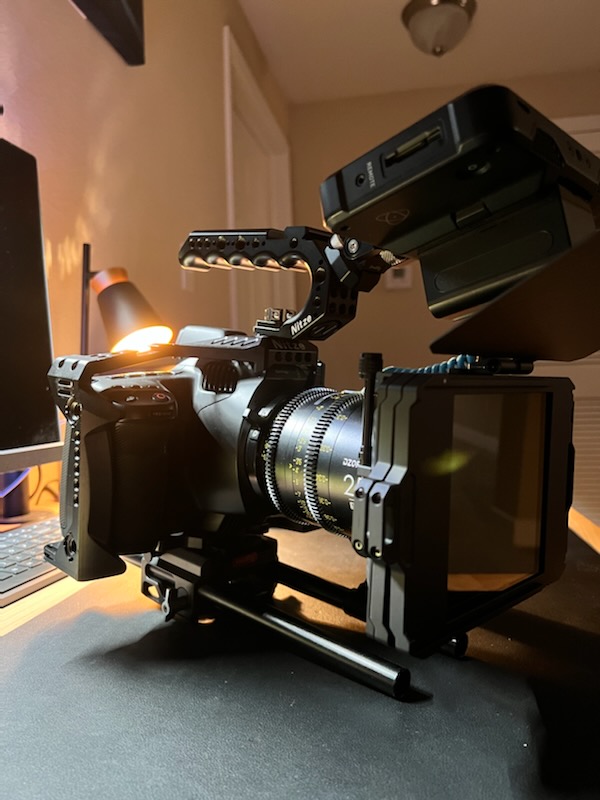A while back Blackmagic contacted me asking if I’d be interested in checking out the Pocket 6K Pro they (somewhat) recently came out with. Having really enjoyed the OG Pocket 6K, I happily agreed to sign the loan paperwork and quickly received, for the span of two weeks, a fresh Pocket 6K Pro. I also took the opportunity to reach out to my friend Jake Baine, owner of PRSM Studios, to weigh in on this article as he’s shot with Blackmagic cameras almost exclusively and has put his 6K Pro through numerous jobs in some crazy environments, amassing far more hours on -and a familiarity with- the camera that I never could in a normal review period. His thoughts, unfiltered, are in blockquotes.
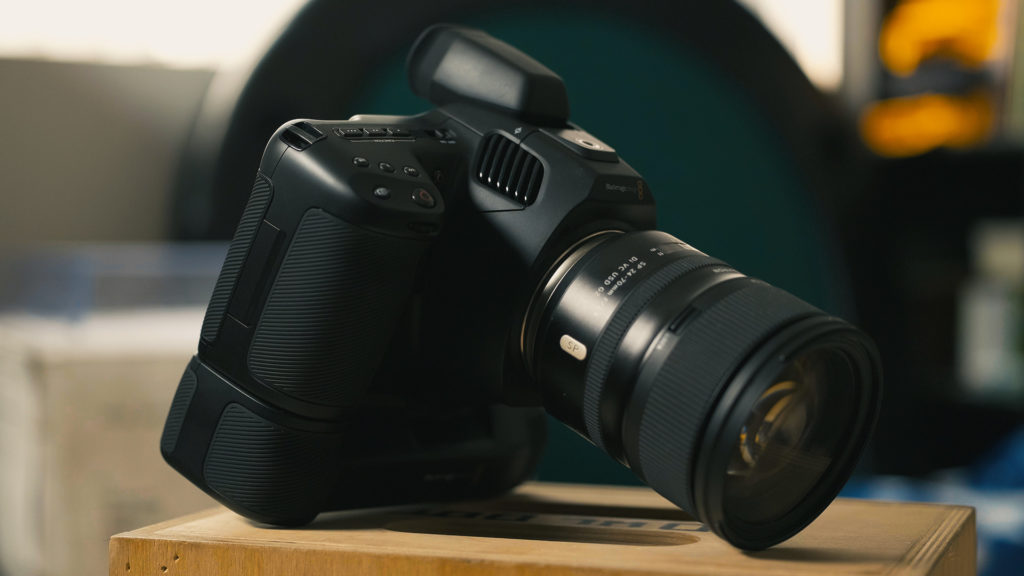
As I mentioned in my last article, I’m trying to be more specific when it comes to classifying cameras in reviews because right now everything is a “cinema camera”. In my head that’s like calling anything with an engine “a car”. Not very helpful, right? In the aforementioned article I had a checklist for what I think constitutes a “true cinema camera” based on the cameras we traditionally see on Film and Television sets:
– Super35 or Full Frame 6K+ Sensor (4K is acceptable)
– 2+ SDI Ports minimum
– Audio of some kind (2x 3pin XLR or 1x 5pin XLR or Similar)
– 2+ Accessory Power Ports (12v and/or 24v)
– Timecode & Genlock via LEMO or BNC
– RAW and 10bit+ LOG modes (ProRes is the clear favorite for compressed)
– XLR or LEMO Power (a built-in V or Gold mount would be nice too)
– PL Mount (native or adapted)
– 14+ stops of Dynamic Range
– Robust Build Quality
– Reliable Recording Media
– Full Image Control (ability to manually adjust all parameters)
– Internal NDs are optional but common these days
– FIZ also seems to be common but I’ll put that in the “optional” category as well
The Pocket 6K Pro has a 6K Super35 sensor, 2 Mini XLRs, Blackmagic RAW and 10bit ProRes, Cfast Recording, 2pin LEMO Power, and internal NDs. So 7 out of 14 of my points. 13 stops of DR and an EF mount are close enough so let’s say 9/14. This puts it squarely in Indie Shooter territory, not really the “Cinema Camera” realm. This is further confirmed by the camera primarily being used in specialty/select shots in some films at Sundance this year as opposed to the main camera. That certainly doesn’t mean you couldn’t use the Pocket 6K Pro for a short or feature (they shot Down With the King on them), but you’d be employing a handful of workarounds if your crew was big enough or your needs surpassed just “getting the shot yourself”. In any case, that’s clearly not what it’s designed for but having “Cinema Camera” in the name made me bring it up. It’s a “Cinema Quality” video camera, let’s say. As I mentioned in the other article, having a replaceable lens and 24p does not a cinema camera make. What I will say is having a “Cinema Quality” video camera at $2500 is an absolute steal. If you won’t use SDI, Timecode, Accessory Power, or a traditional body style then you’d be hard pressed to find a better camera for your needs at this price point and if all you care about is the image, Blackmagic RAW constantly and consistently delivers (not to mention how many updates these cameras tend to get).
Moving on to my brief experience with the camera, the review kit I received came with three batteries (Sony NP-F style now, as opposed to the Canon ones from before), the battery grip, the camera, the viewfinder attachment, and absolutely no recording media. Not having CFast cards on-hand, I ran my tests with my fastest SD card and my G Tech MobileSSD. Luckily you’ve got options when it comes to these cameras! One thing to note is you can either use the SD card or the SSD, not both, in addition to the CFast card. In other words, the SD or SSD are always “Slot 2” to the CFast card’s “Slot 1”. The batteries do kind of run out quickly, but going with the NP-F style seems to have helped the situation and having the battery grip made it so I wasn’t stressed about the camera dying, at least during my modest tests.
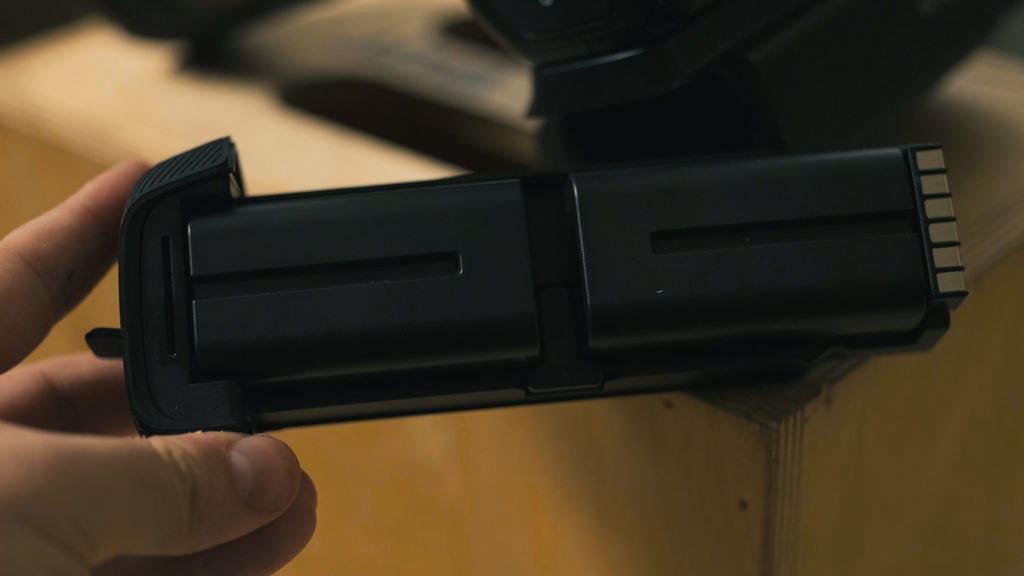
I’ve able to get around an hour of shooting on one battery. Sometimes less. It’s still not great and I always travel with 6-7 batteries to make sure I never run out of juice. I usually keep all of them on the charger while shooting and when my battery dies, I plop it onto the charger and take a fully charged one off to use. This allows me to shoot for hours on end as the time it takes me to burn through 2 batteries is enough time to allow the rest to fully charge again. You can also use a V-mount too.
First, and I just have to get this out of the way because it jumped out at me right when I picked the camera up, the body design annoys me. I have no clue why it’s shaped the way it is. The Pocket Cinema Camera series from Blackmagic is interesting because it’s probably one of the more “confusing” cameras available today, offering ostensibly professional-level image quality in a decidedly amateur-level package. It’s not a DSLR, why build it like one? It’s an oversized one at that. It’s not small, so the “Pocket” moniker (which was applicable for the OG Pocket Cinema Camera, a camera that still holds up to this day) makes little sense and the grip is almost too big for my hand, making it feel like it’s going to slip out.
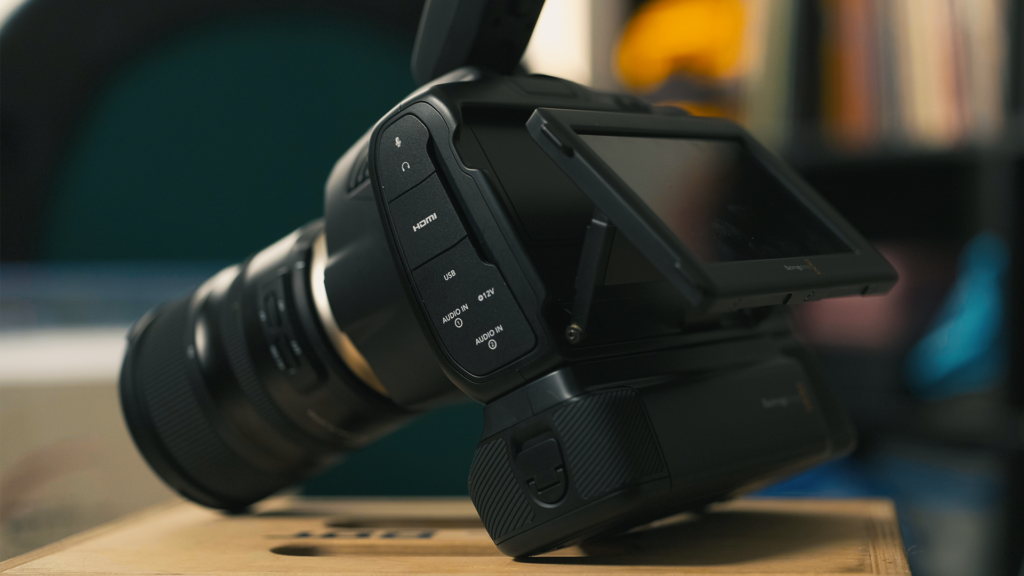
The battery grip is similarly confusing, as it’s also built in DSLR style attached to the bottom of the camera and makes it so you can’t set it down flat, potentially causing damage to the lens or mount. There’s no comfortable way to hand-hold the camera straight out of the box either, especially with the battery grip on, but even so, your left hand naturally rests right over the front vent, blocking it. There is no continuous AF on this camera, so you will be holding it like that to focus manually if you don’t invest in a rig for it. I know we’re coming in hot with the negativity, but it’s literally the first thing I felt when pulling the camera out of the box and I’ve yet to find a proper, workable solution for it. I swear that’s my only real complaint. Jake doesn’t seem to mind:
This is my second camera from BMD so I am used to the ergonomics of their cameras. It seems BMD’s style is awkwardly-shaped cameras and, in my honest opinion, it doesn’t bother me too much. Sure, I’d love a box form camera but the weird, bloated football shape of the Pocket 6K Pro isn’t a deal breaker for me because rarely EVER am I using it bare without a cage and a small build around it to even-out the weight and balance. When it’s built out, it’s actually a pretty nice shape. I’ve seen YouTubers complain about how the camera is unbalanced and “hurts their wrists after a shoot day” which, sure, the camera is admittedly awkward. But complaining about sore wrists after a shoot seems a little prima donna to me.
Where I will complain is the build quality of these cameras. BMD had to cut corners in one fashion or another in order to keep their camera prices where they are and as soon as you pick up a Pocket 6K Pro, you immediately know where corners were cut- and it is in build quality. The thing is plastic-y as hell. It really doesn’t inspire any confidence in the longevity of the camera if you use it heavily. I’ve had mine since March and I haven’t had any issues but when you’re a part of BMD camera communities online and see other 6K Pro’s falling apart, it really leads to a lack of confidence in the build of the camera. Sure, you could argue that the camera is inexpensive and could be replaced easily but it’s a hassle. Plus, for some, buying another replacement is not within the realm of possibility. Buttons are responsive and switches are decent. The ports on the camera seem to be well built (for now). I haven’t had any issues. There is a fan built into the camera and even when shooting in Las Vegas desert heat, I have had no overheating issues. The fan doesn’t interfere with audio either.
Aside from that there’s plenty to love about this most recent offering from Blackmagic, and the general gripes I (and others) had about the original Pocket 6K were thankfully addressed here. We’ve got a tiltable screen so you don’t have to hold it in front of your face like your Aunt filming the school play with her iPad, and it’s much brighter too so you can use it outside without necessarily needing a hood, which are both huge additions. There’s also a viewfinder attachment you can get, which is about the same quality as most built-in viewfinders tend to be, which I found to be pleasant enough to use but does appear to be warmer in color temp than the LCD. Since you can select what display elements go where, I set it up so the main LCD would show the image with a stripped-down UI for monitoring, and the viewfinder had all the “diagnostics” like False Color, Battery Life, Card Time Left, etc. set to “always on” so I could just peek in the viewfinder for critical info, but could focus on the monitor as the source of the “creative” work happening with minimal distracting screen elements. You can also “swipe away” the UI on the LCD if you just wanted to toggle between both styles of display on the main screen, or don’t have the Viewfinder. That touch-screen UI really is nice.
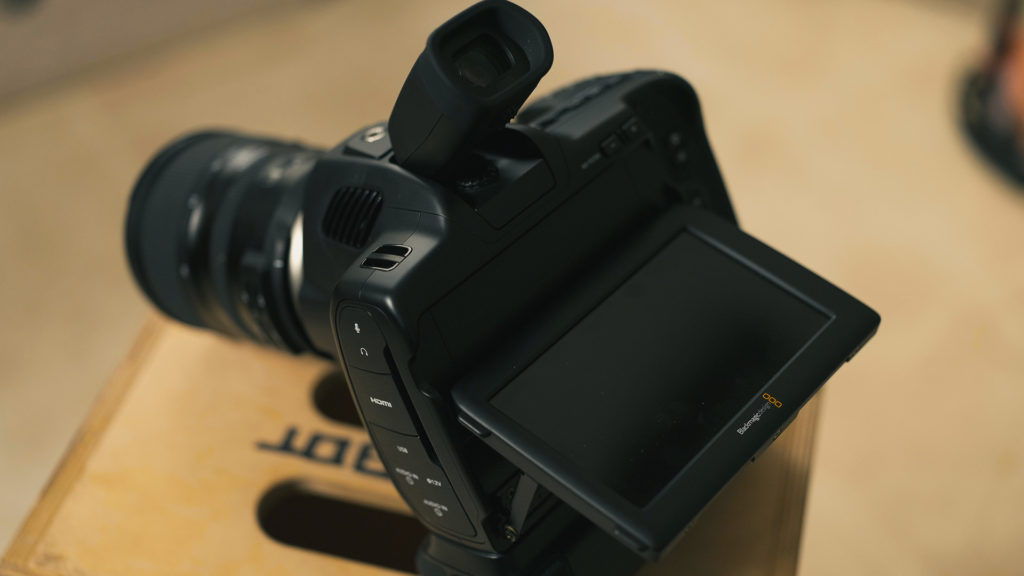
The screen on the Pocket 6K Pro is BRIGHT. I mean, bright bright. It is brighter than my Atomos Shinobi and there have been times where in direct Las Vegas sunlight, my external Atomos monitor was difficult to see and I had to use the internal screen of the Pocket 6K. The screen is responsive, and the tilting function is welcomed. It makes it easy to monitor at odd angles if you don’t have an external monitor.
Now, despite being a bright screen, the screen is NOT at ALL color accurate. I was one of the first in America to get the Pocket 6K Pro and the screen had an awful green/blue tint to it. It seems the screens weren’t calibrated out of the factory leading to every Pocket 6K Pro screen to be horribly calibrated out of the box. BMD caught wind of this and added a calibration feature which isn’t the best, but allows you to correct this out of the box. I was able to get mine close to the color of my Atomos Shinobi but I still wouldn’t rely on the built in screen for anything other than framing and exposure. Another pitfall of an affordable camera I suppose. Not a deal breaker.
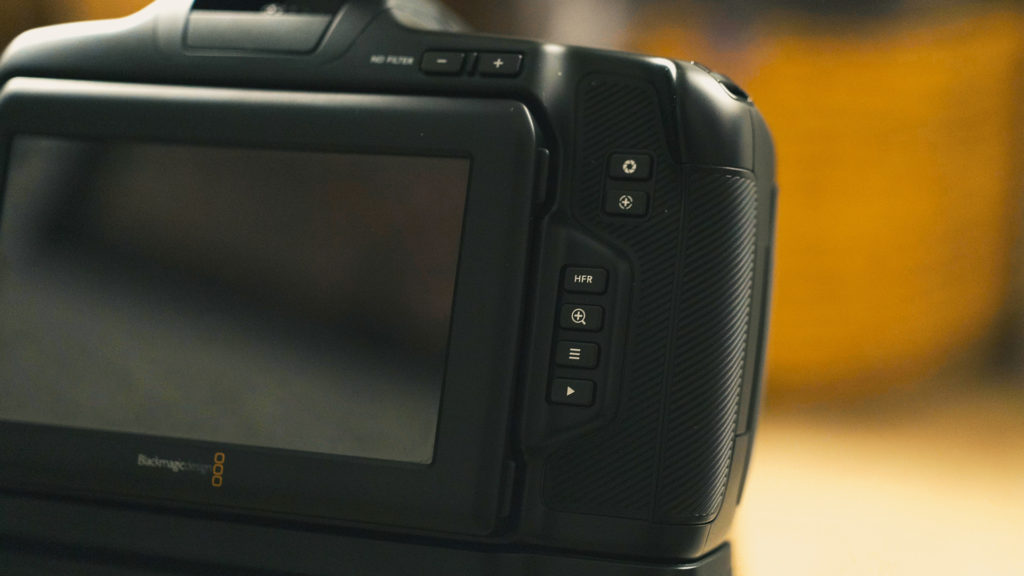
We’ve also got the addition of BUILT-IN ND FILTERS! At this point I honestly can’t forgive companies for not including built-in NDs on their cameras (RED V-Raptor, no ND’s?). They’re basically a necessity at this point. It clearly doesn’t take up a ton of room in the body itself and you can ensure that you’re sourcing the best NDs (right, companies? That’s what you’re doing?) as to not negatively affect the image. Here, Blackmagic has given us a modest 6 stops of ND which solves the problem I noted in my previous review of the OG 6K in which you had to be careful about which ND’s you used as the Pocket Cinema Cameras don’t come with an IR-Cut filter. For those unaware, if you use a standard ND on these cameras (as opposed to an IRND or similar where there’s an IR-Cut coating added) the image will come out more and more red as the strength of the ND increases. While that’s still the case here, the built-in ND’s do appear to have an IR cut element so unless you need more than 6 stops of reduction, you should be good to go. In my tests the colors of the image looked the same when cycling through the NDs. It would have been rad to see the filters able to “stack” allowing for up to 10 (or even 12) stops of ND but again, this is an extremely affordable camera all things considered so 6 is perfectly reasonable. The Alexa Mini has 6 stops of ND, if you want to think of it that way.
The NDs in the camera are great. I love them. They DO have an IR cut in them, but it is minimal. There is STILL IR pollution in the camera and you can see this with a slight shift towards magenta when you stop down with the NDs. Black polyester shirts will start to look like a dark maroon. Now, this is just due to the fundamental laws of physics and how light works. Even ARRI cameras with their built in NDs suffer from this same issue and expensive ND filters suffer too. I will say, the built in NDs fare WAY better than using the normal pocket 6K with external NDs. I had a friend show me a clip from his Pocket 6K (not pro) where he shot someone with a black polyester shirt with a Tiffen ND and the shirt turned completely red in the image shot on the camera. This isn’t an issue on the 6K Pro thanks to the built in IR cut. You still get some pollution, but it’s very minimal. I would recommend buying a RawLite OLPF filter for your 6K Pro to cut out the remaining IR pollution since these filters have IR cut built in. Very happy with the built in NDs.
One thing we don’t have, and this isn’t a knock on the camera as most don’t, is stabilization. If you’re going handheld, you’ll want to invest in a lens or set of lenses with some nice Optical Image Stabilization. Obviously you don’t have to, but you’d be glad you did.
In regards to the on-body controls and ports, after the standard 3.5mm Mic and Headphone jacks, the camera simply offers 2 Mini XLR jacks and a full size HDMI port, suggesting it’s not intended to be used with too much extra equipment. It’s also sparse on buttons, only offering 3 to customize in addition to the ISO/S/WB keys, the ND +/- selector, and Magnify, Menu, Playback, & Slowmo keys, but it makes up for that in the simplistic utility that the touchscreen provides. The Blackmagic menu system almost feels more like an app than something seen on cameras, and that’s potentially a good thing. It’s very responsive, everything is exactly where you would expect it to be, and there’s nothing in there that’s confusing: all the options you need and nothing more. I love that you can just tap parts of the display and it’ll either cycle through various versions of that thing, or give you the option to change that perimeter. You want to change the FPS? Poke the area with the frame rate. Want to zoom in? Double tap it or pinch zoom up to 8x, and slide your finger around to move the zoom-zone. Formatting the card? Click the card area! It’s also got nice “oops” protection where it has you hold your finger down for 3 seconds to commit to formatting a card. I really like that. Sure, one could want more customizability or granular options, but at the end of the day these cameras are designed to get you a great image at an affordable price point. These cameras are “iOS” not “Linux”, you know what I mean? Jake and I seem to agree on this one:
BMD has the best menu system out of any camera ever. Period. It’s the Apple of camera systems. It’s so clean, responsive and well laid out. I have nothing more to say other than it’s the BEST. Period. The camera also has a Bluetooth function allowing you to connect up to 10 cameras to an iPhone or iPad for multi-cam function and setting changes. It syncs timecode as well allowing you to trigger up to 10 cameras to record at once which saves so much time in the edit since you won’t need to line up clips to sync audio.
A sort of “hidden” feature I found was the slate. Hidden in the sense that I didn’t read the user manual, as I’m sure it’s in there, but anyway if you swipe from the left or right of the screen you’ll get a slate with boxes for Project Name, Director, Camera letter, and Camera Op, as well as clip-level values of Lens Data, Reel, Scene, Take (with auto-advancing letters ie. 4a 4b 4c), Int/Ext and Day/Night. It also has a box labeled “Good Take Last Clip” that puts a flag on the previous clip so you know what’s good at a glance in Post. The “Lens Data” form auto detects it from the attached lens, but lets you edit it anyway as well (or if it’s not an electric lens that transmits that data). It has inputs for Lens Type, Iris, Focal Length, Focus Distance, and Filter (which you’d be filling in manually either way). Everything feels connected on these cameras, and the Lens Data is no different; if you zoom or focus while in the Lens Data menu, the appropriate values update instantly. I seriously, seriously love this feature. I wish every manufacturer had such a great slate feature, it’s fantastic.
One thing I appreciate about the body is it has a locking 12v LEMO plug for wall power. So many cameras use a barrel plug that can be jostled out if a strong enough wind blows through, and I hate that. Next to the power plug is a USB-C port allowing you to use standard computer SSDs as storage solutions. In that vein, my 500GB MobileSSD suggested that it was able to record 6K BRAW 3:1 at 24fps for 32minutes before hitting record, instead doing so for almost twice that long coming in at 50 minutes. This tracks with how the original 6K performed, constantly out-recording the on-screen estimate by a considerable margin. On a fascinating but unrelated note, my MobileSSD from G-Tech shows up as a “SanDisk X600 M.2” on my Chromebook, which is a diagnostic side-benefit of the Linux-based OS that I didn’t expect or even know about.
Instead of explaining it, I’ll just go ahead and list the frame rates and resolutions available in the Pocket 6K Pro while we’re here:
6144 x 3456 (6K) up to 50 fps
6144 x 2560 (6K 2.4:1) up to 60 fps
5744 x 3024 (5.7K 17:9) up to 60 fps
4096 x 2160 (4K DCI) up to 60 fps
3840 x 2160 (Ultra HD) up to 60 fps
3728 x 3104 (3.7K 6:5 anamorphic) up to 60 fps
2868 x 1512 (2.8K 17:9) up to 120 fps
1920 x 1080 (HD) up to 120 fps
Storage rates will obviously changed based on your frame rate, but continuing BMD’s commitment to simplicity and ease-of-use, you can save to Blackmagic RAW 3:1, 5:1, 8:1, 12:1, Q0, Q1, Q3 and Q5 in all resolutions except 1080, and various flavors of ProRes 422 in DCI, 4K UHD, and HD. Nice of Blackmagic to use such a widely accepted format for their compressed options here.
The video quality is, as usual with BMD, amazing. It cuts in with Arri and RED footage seamlessly and the Dual Native ISO is fantastic for low light shooting. You can go up to 3200 ISO and still have a decently clean image. You could even boost to 6400 and with some NR in post, could still have a usable shot.
The camera shoots to both BRAW and ProRes which is welcomed for projects that require a quick turnaround. Being able to shoot at 6K full sensor at 50fps is insane when cameras twice its price cannot do this. The 2K 120fps does have a significant crop but still looks phenomenal.
The footage has that milky smooth feel to it. Colors are separated and pretty– and the 13 stops of DR are great when shooting in dynamic environments. I’ve heard people criticize the 13 stops of DR but in all reality, most cameras that claim 15+ stops of DR actually only have 12-13 stops of usable DR. I have no complaints on DR with the Pocket 6K Pro. I notice little to no difference between the G2 that I owned before.
When shooting in 6K full sensor, the rolling shutter is apparent. I normally shoot in 5.7K which has a crop factor that I don’t even notice. When shooting in 5.7K, the rolling shutter is cut down significantly. I would only use 6K resolution for shots with little to no movement and 5.7K for shots with significant movement.
Overall, this sensor packs a punch and, in my opinion, holds it’s own with cameras 2-3x it’s price.
As an example of the camera’s quality, Jake recently shot this project for Metal Umbrella on the Pocket 6K Pro:
I still believe this is one of the best cameras on the market today. Too many people treat cameras like clothes, looking for the biggest name to flex (I’m looking at you, RED). Sure, BMD cameras can have a stigma but I think they are on the forefront of democratizing professional features and video quality to the mass market. There is little on this camera that leaves me frustrated. My only gripe is, like I said, the build quality. But that aside, this camera is a power house and, in the hands of the right person, is a real tool to be reckoned with.
I have to agree there; Blackmagic has to be applauded for constantly creating cameras that are both affordable and create beautiful images on top of their seeming dedication to keeping the cameras competitive with firmware updates and RAW revisions. One thing that bugs me about many camera manufacturers is their habit of seemingly releasing and immediately forgetting about their products, only updating their cameras if there’s a serious bug that needs fixing. I’d love to see more companies go the way of Blackmagic and commit to adding features whenever possible to their already-existing line of cameras instead of instantly coming out with new ones. By doing this BMD has created a huge, dedicated fan-base that keeps coming back because they know they as customers will be taken care of even after they’ve parted with their money.
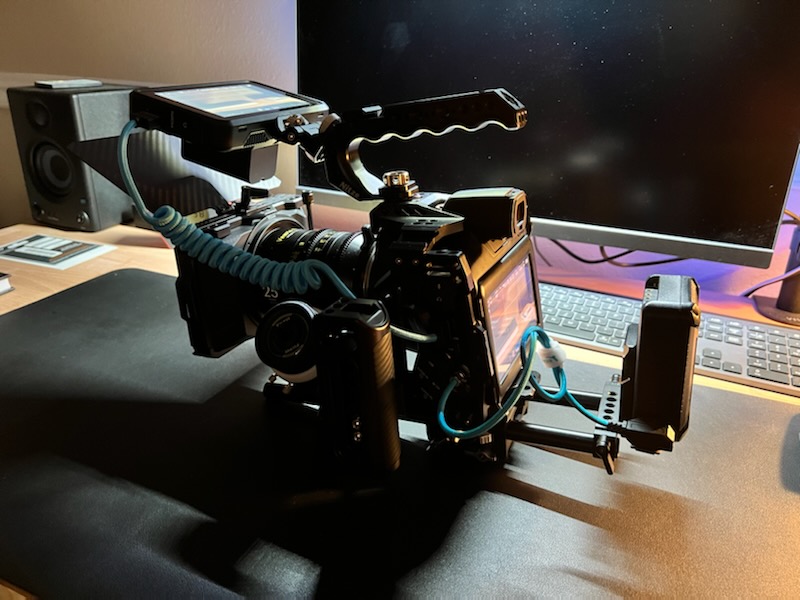

Filmtools
Filmmakers go-to destination for pre-production, production & post production equipment!
Shop Now